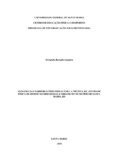| dc.creator | Lameira, Fernanda Rossatto | |
| dc.date.accessioned | 2021-05-05T17:20:15Z | |
| dc.date.available | 2021-05-05T17:20:15Z | |
| dc.date.issued | 2018-08-06 | |
| dc.identifier.uri | http://repositorio.ufsm.br/handle/1/20780 | |
| dc.description.abstract | Aging is a natural process in which various changes occur in the body and in people's
lifestyles. These variations are derived from numerous factors such as socioeconomic
conditions and chronic diseases. The environment in which the elderly live is also one of the
factors that influence lifestyle and interfere with the course of aging. Considering the
differences between localities and the high rate of inactivity in old age, this study aims to
analyze the main barriers perceived by elderly people, from rural and urban areas, to practice
physical activity. The approach was made through home visits in three urban districts and
three rural districts, with different socioeconomic levels (high, medium and low incomes). To
evaluate the barriers, a questionnaire was applied that evaluates the perceived barriers to the
practice of physical activity. The comparisons between the groups and the barriers were
performed by the Chi-square test (CHI²). Participants were 208, of which 141 were urban and
67 were rural. The majority of the individuals surveyed are female and married, with a mean
age of 70.34 ± 7.86 years, and on average presented a high BMI (29.71 ± 5.29), accusing
excess weight, mainly between the women. The most cited perceived barrier was the lack of
companionship to practice physical activities, followed by having some disease or injury that
interferes in practice. When comparing the barriers between the sexes and the localities, there
was a significant difference in the barrier "feel lazy or tired to do physical activity" with urban
women being the most cited (20.7%), and barrier 2 "having some injury or illness that
interferes with physical activity "was also more cited by women (29.3%) than by men
(12.5%). It is concluded that the prevalence of perceived barriers to the practice of physical
activity in the elderly interviewed is high, especially the fact that there is no company to
practice physical activities. Possessing some illness or injury that interferes in practice was
the second most reported barrier by most of the elderly in both locations. | eng |
| dc.language | por | por |
| dc.publisher | Universidade Federal de Santa Maria | por |
| dc.rights | Attribution-NonCommercial-NoDerivatives 4.0 International | * |
| dc.rights.uri | http://creativecommons.org/licenses/by-nc-nd/4.0/ | * |
| dc.subject | Envelhecimento | por |
| dc.subject | Barreiras | por |
| dc.subject | Rural | por |
| dc.subject | Urbano | por |
| dc.subject | Aging | eng |
| dc.subject | Barriers | eng |
| dc.subject | Urban | eng |
| dc.title | Análises das barreiras percebidas para a prática de atividade física de idosos no meio rural e urbano do município de Santa Maria, RS | por |
| dc.title.alternative | Analysis of perceived barriers to practice of physical activity of elderly people in the rural and urban environment of the municipality of Santa Maria, RS | eng |
| dc.type | Dissertação | por |
| dc.description.resumo | O envelhecimento é um processo natural no qual ocorrem diversas alterações no organismo e
no estilo de vida das pessoas. Essas variações são derivadas de inúmeros fatores como
condições socioeconômicas e doenças crônicas. O meio em que o idoso vive também é um
dos fatores que influenciam no estilo de vida e interferem no curso do envelhecimento.
Considerando as diferenças entre as localidades e o alto índice de inatividade na velhice, o
presente trabalho tem por objetivo analisar as principais barreiras percebidas por idosos, da
área rural e urbana, para a prática de atividade física. A abordagem foi feita através de visitas
domiciliares em três bairros urbanos e de três distritos rurais, com diferentes níveis
socioeconômicos (rendas alta, média e baixa). Para avaliar as barreiras foi aplicado o
questionário que avalia as barreiras percebidas para a prática de atividade física. As
comparações entre os grupos e as barreiras foram realizadas pelo teste Qui-quadrado (CHI²)..
Participaram da pesquisa 208, sendo 141 do meio urbano e 67 da área rural. A maioria dos
indivíduos pesquisados é do sexo feminino e casada, com idade média de 70,34±7,86 anos, e
apresentaram em média um IMC elevado (29,71 ±5,29), acusando o excesso de peso,
principalmente entre as mulheres. A barreira percebida mais citada foi o fato de não ter
companhia para praticar atividades físicas, seguido de possuir alguma doença ou lesão que
atrapalhe na prática. Quando se comparou as barreiras entre os sexos e as localidades, houve
diferença significativa na barreira ―sente preguiça ou cansaço para fazer atividade física‖
sendo as mulheres urbanas as que mais citaram, (20,7%), e a barreira 2 ―ter alguma lesão ou
doença que atrapalhe na hora de fazer atividade física‖ também foi mais citada pelas mulheres
(29,3%) do que pelos homens (12,5%). Conclui-se que a prevalência de barreiras percebidas
para a prática de atividade física nos os idosos entrevistados é alta, principalmente o fato de
não ter companhia para praticar atividades físicas. Possuir alguma doença ou lesão que
atrapalhe na prática foi a segunda barreira mais relatada pela maioria dos idosos das duas
localidades. | por |
| dc.contributor.advisor1 | Santos, Daniela Lopes dos | |
| dc.contributor.advisor1Lattes | http://lattes.cnpq.br/0357112600823721 | por |
| dc.contributor.referee1 | Azambuja, Cati | |
| dc.contributor.referee1Lattes | XXXXXXXXXXXXXXX | por |
| dc.contributor.referee2 | Copetti, Fernando | |
| dc.contributor.referee2Lattes | XXXXXXXXXXXXXX | por |
| dc.creator.Lattes | http://lattes.cnpq.br/3547778740341673 | por |
| dc.publisher.country | Brasil | por |
| dc.publisher.department | Ciências da Saúde | por |
| dc.publisher.initials | UFSM | por |
| dc.publisher.program | Programa de Pós-Graduação em Gerontologia | por |
| dc.subject.cnpq | CNPQ::CIENCIAS DA SAUDE | por |
| dc.publisher.unidade | Centro de Educação Física e Desportos | por |



